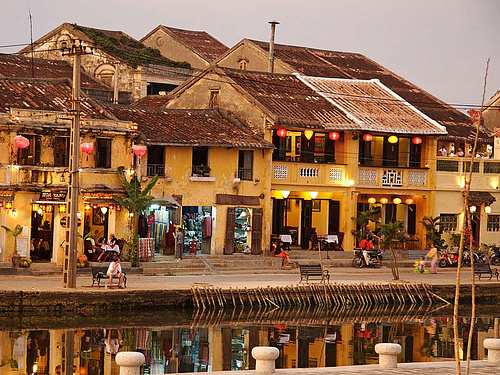Hoi An Ancient Town in Hue city of Viet Nam
Hoi An, known as Fai-Fo or Faifoo, is a city with a population of approximately 120.000 in Vietnam's Quang Nam Province and noted since 1999 as a UNESCO World Heritage Site.
Old Town Hoi An, the city's historic district, is recognized as an exceptionally well-preserved example of a South-East Asian trading port dating from the 15th to the 19th century, its buildings and street plan reflecting a unique blend of influences, indigenous and foreign. Prominent in the city's old town, is its covered "Japanese Bridge," dating to the 16th-17th century.
History of Hoi An
A slow stroll through town reveals its gems. Hoi An has to this days well preserved its most sacred treasure, the centuries-old architecture. The town used to harbor foreign traders back in the 17-18th, and once is an important heavily-frequented trading port in Southeast Asia. The foreigners come from all corners of the world, but mostly are Chinese and Japanese nationalities. Some come and go, but many settle in permanently and etch their marks into the history of Hoi An.

Mixing together with Vietnamese design, Chinese and Japanese accents melt and create a picture-perfect Hoi An of the late 19th century, which it has somehow remained mostly intact since. The end product is an oddly strange-yet-familiar sight that exists nowhere else in the world. To this day, few descendants of the foreign traders remain but the architectural setting manages to survive the damage of time.
In 1999, UNESCO formally recognizes Hoi An is a World Heritage Site. There are the things that make up the reputation. Hoi An is home to many temples, pagodas and the ancient homes that bear its very unique mark. The density of such sites is unlike any other in Vietnam. These places carry with them the history of Hoi An itself. The depiction of its formation, its once-prosperous merchant past, its progress and how it manages to become one of today are all well documented, in words and in priceless relics.
The town is not just reminiscent of the past, it truly takes one for a slow enlightening journey to the past. Such journey is simply unthinkable most elsewhere in Vietnam. It is only possible because of the careful and dedicated works that have gone into preserving and presenting its way - efforts that have come as the result of the UNESCO recognition. Enjoying the spotlight and catering to the increasing number of tourists flooding its narrow streets hoping to catch a glimpse of the past, hotels and resorts are now sprouting up all over town.
Hoi An also has four museums highlighting the history of the region. These museums are managed by the Hoi An Center for Cultural Heritage Management and Preservation. Entrance to the museum is permitted with a Hoi An Entrance Ticket.
Weather of Hoi An
Weather is limited to the season of May/June - end of August when the seas are calm and wind changes direction and comes from the South. The remainder of the year the weather is intermittent between rain & cold and hot & mild. Popular activities such as visiting offshore Cu-lao-Cham islands are only guaranteed to be likely during the short season of end of May to end of August, which is the high season for domestic tourism.
Amost of the things sold in town, there are only 3 different categories. First is souvenir, the second being clothing and the last is food, both western and Vietnamese. The souvenir is not something to write home about, since offerings are limited in diversity throughout the country. Hoi An is better known for its tailor shops, which mostly service personal bespoke orders. Tourists circulate rumor that people stay in this little sleepy town for entire weeks doing nothing, waiting just to have their shirts made to the perfect fit. Most designs are traditional Vietnamese in nature, with some offer contemporary twists and touches of foreign taste as well.
Hoi An lantern makes a perfect house deco - and inexpensive
Coupled with the right prices, Hoi An is truly a shoppers’ paradise, one that dictates its western customers on a unique oriental sense of style. Paradox does not end. One imagines never being able to find western food in such a hardcore Vietnamese setting. That turns out not the case. Hoi An is home to multiple restaurants that serve big hearty American meals with only a small portion of the menu dedicated to local food. The locals prefer their sidewalk vendors to the many re-innovated house-turned-restaurants out there.
.jpg)
And it is in Hoi An that their inner peace shall be found, paradoxically in the face of all the money being changed hand. As for a fitting end to a story of many extremes, Hoi An is, sadly, situated in one of the poorest provinces in the country. Apart from the glamour of the tourism-enriching little town, Quang Nam’s population generally lives at the poverty line level. A typical drive from Danang’s airport or train station to Hoi An soon enough will reveal all the stories that are silently told.
keyword: niceplaceworld, nice place on world, nice place, beatutiful place, nice scene, nice scenery, beautiful scene, travel, travel vietnam, beautiful vietnam, https://niceplaceworld.blogspot.com/
keyword: niceplaceworld, nice place on world, nice place, beatutiful place, nice scene, nice scenery, beautiful scene, travel, travel vietnam, beautiful vietnam, https://niceplaceworld.blogspot.com/









No comments:
Post a Comment